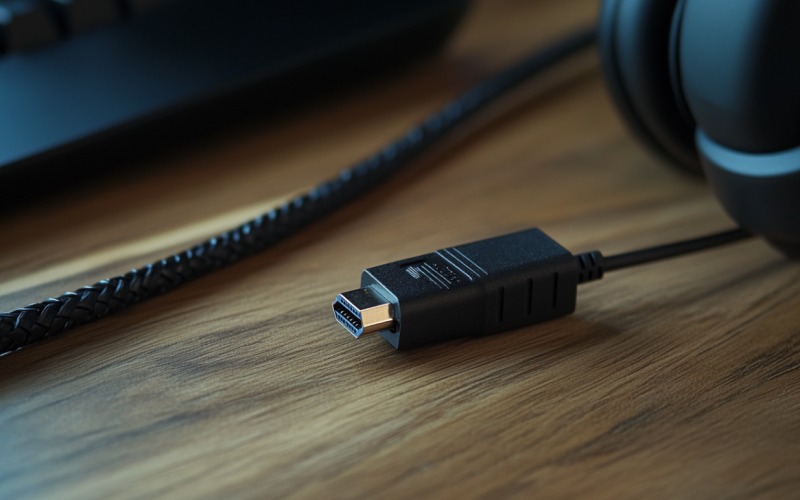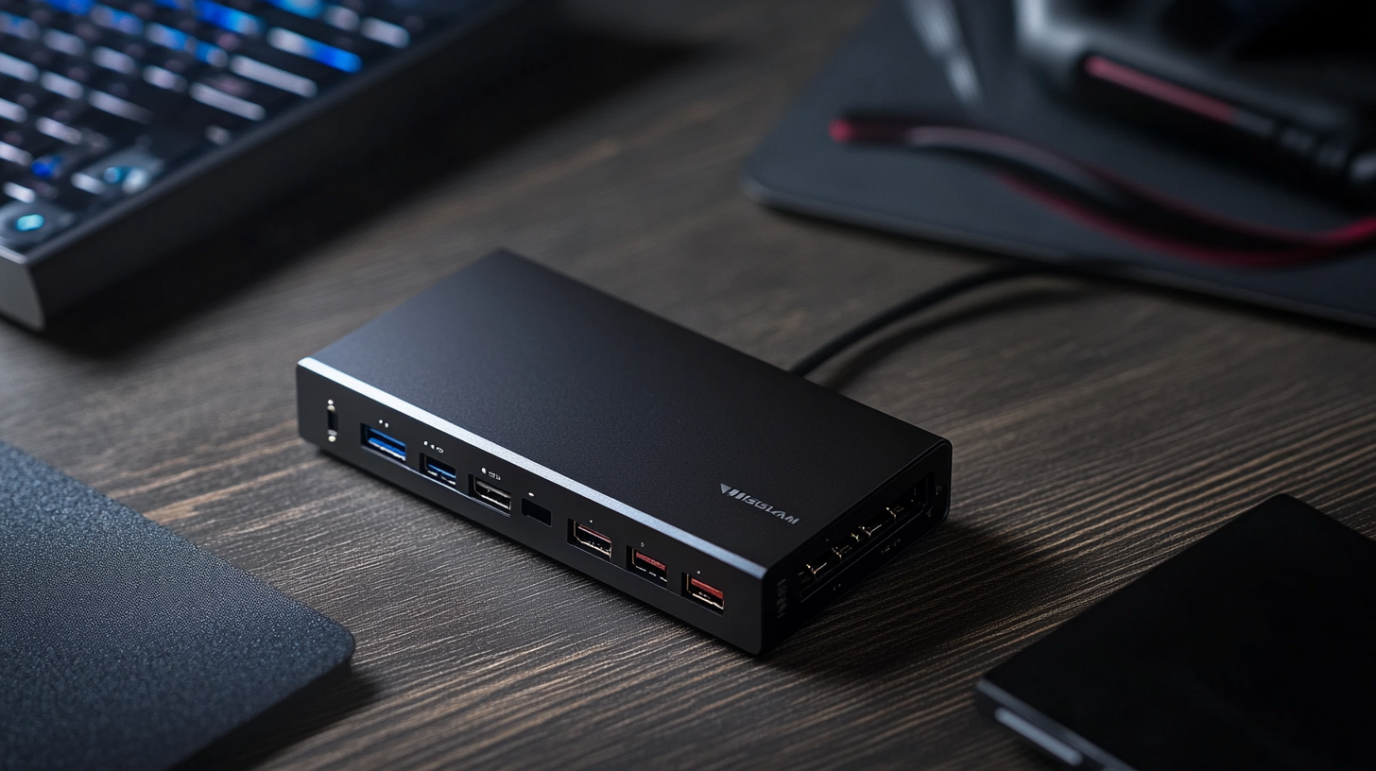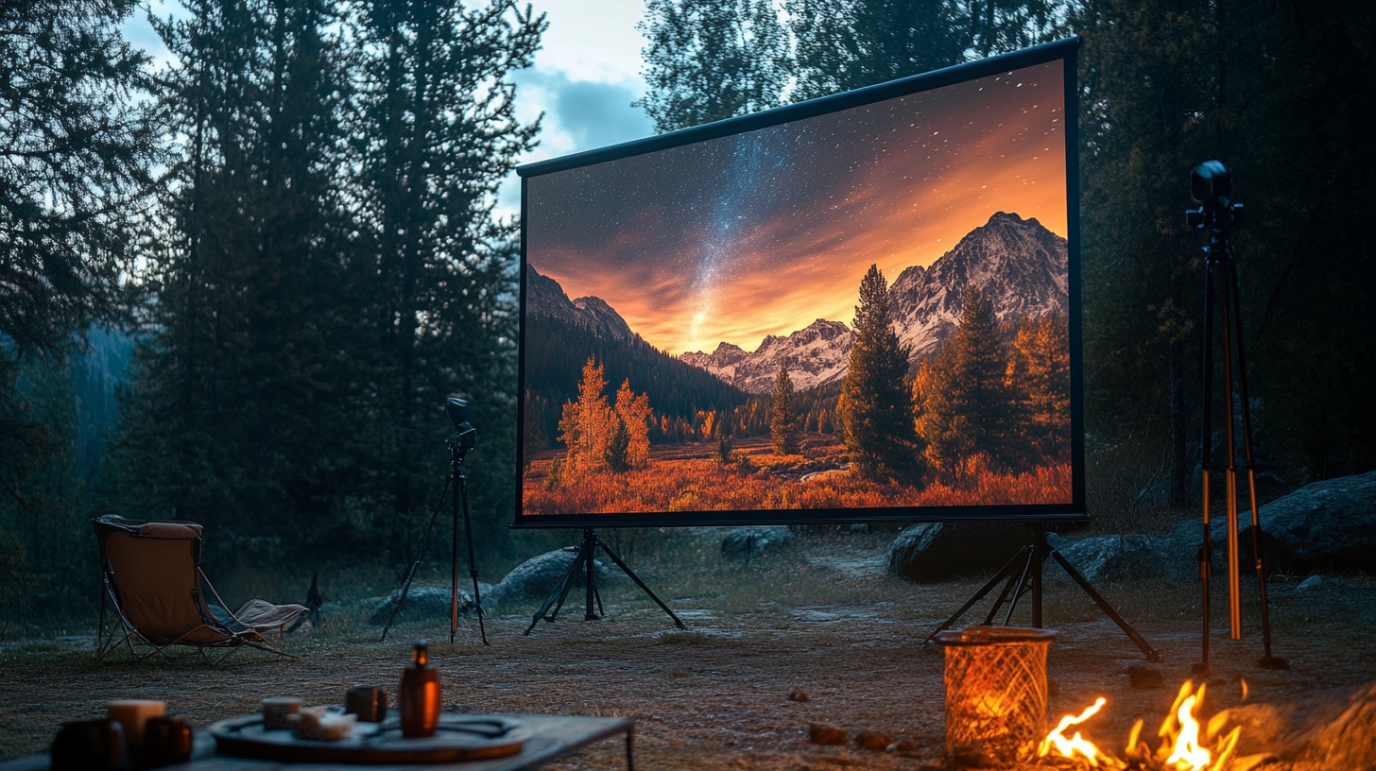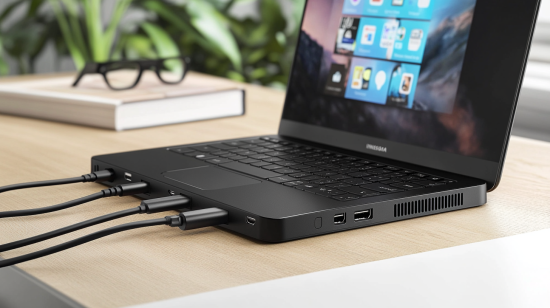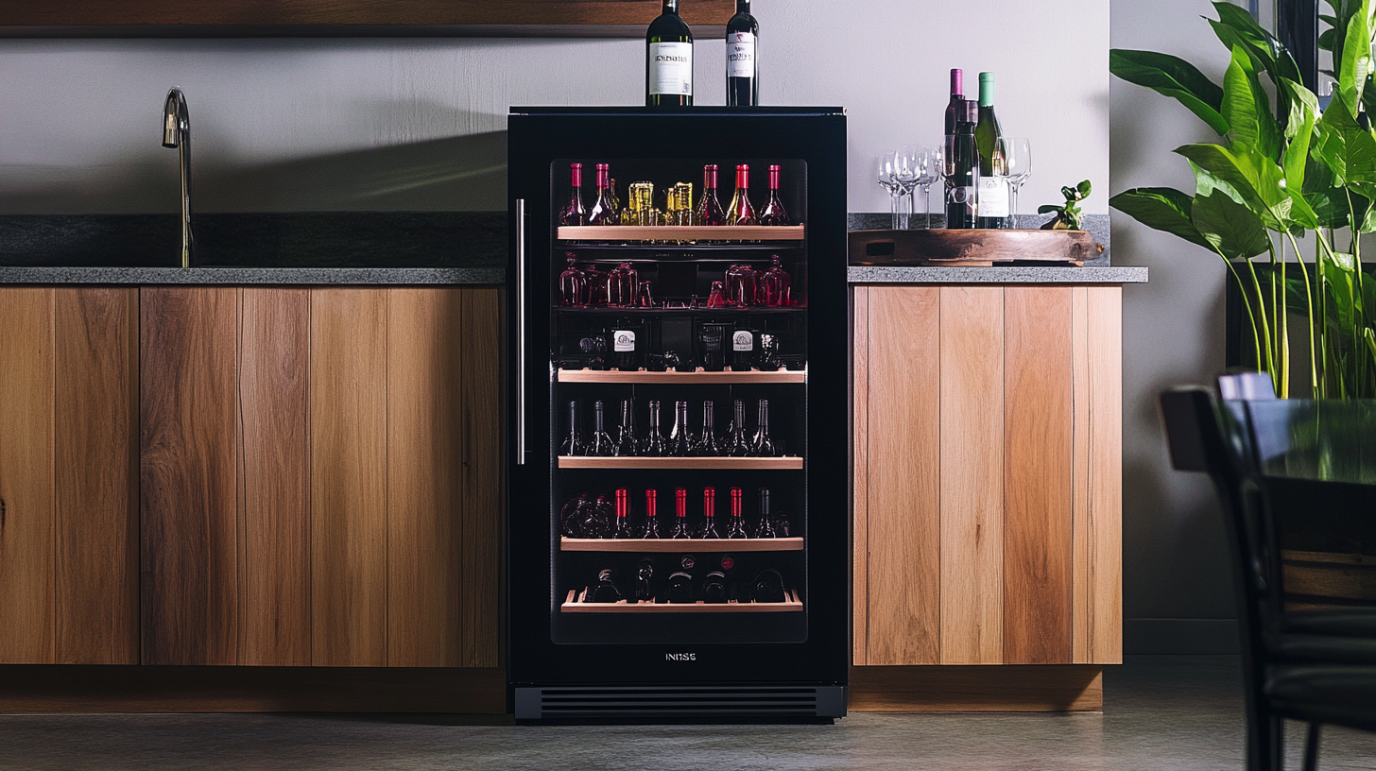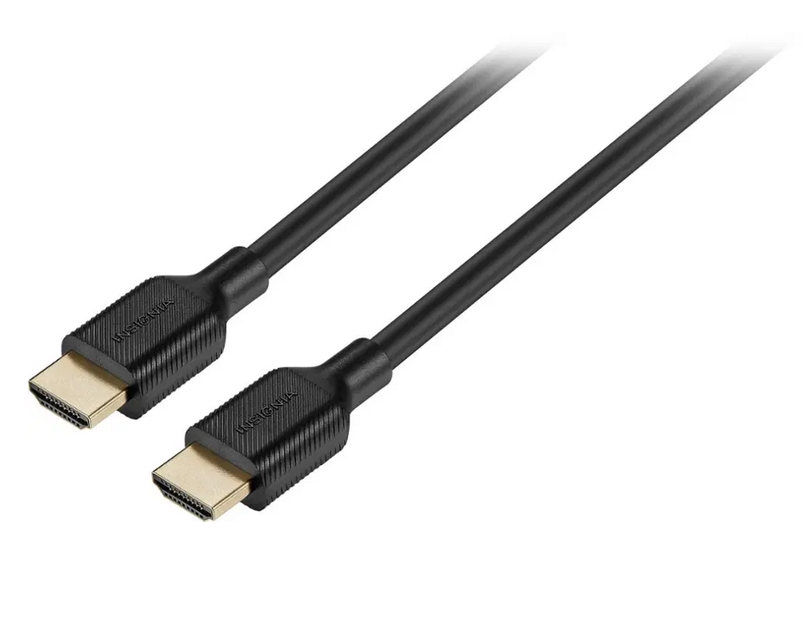
Insignia™ – 6′ 4K Ultra HD HDMI Cable – Black
- Efficiently transmit video and audio Connects an HDMI source to your HD-capable TV, monitor or projector.
- Supports up to 4K resolution at 60 Hz A resolution of 3840 × 2160 at 60 Hz displays true-to-life images.
- Ethernet capability Provides web connection to an internet-enabled device.
- 24 K gold-plated connectors Helps maintain signal strength.
- Reliable signal transfer A 360° metal shielding and tin-plated conductors ensure a quality connection.
- Plug-and-play technology Requires no additional software for an effortless connection.
- Flexible placement options A 6 ft. durable cable gives you that extra needed length.
- Brought to you by Best Buy Insignia brings you affordable, dependable products with all the features you need.
$24.99
Finding Clarity in the Cable Confusion: A Tech Enthusiast’s Perspective
As I stared at the tangled mess behind my entertainment center last month, I realized something that many of us tech enthusiasts eventually come to terms with: cable management is the unsung hero of a clean setup. Among the various cables lurking behind our devices, HDMI cables remain the most essential connectors in our digital lives. After my third cheap cable failed during a crucial movie night, I decided to explore Insignia’s HDMI cable offerings, and what I discovered was eye-opening.
Let me walk you through everything I’ve learned about Insignia HDMI cables – from features and compatibility to pricing and performance. Whether you’re setting up a new gaming console, connecting a soundbar, or simply upgrading your aging cables, this comprehensive guide will help you make an informed decision without the technical jargon overload.
What Exactly Are Insignia HDMI Cables and Why Should You Care?
Insignia is Best Buy’s in-house brand, and if you’ve shopped for electronics before, you’ve likely encountered their products. Their HDMI cables might not have the flashy marketing of Monster Cables or the boutique appeal of AudioQuest, but they occupy that sweet spot between budget and premium options.
When I first picked up an Insignia HDMI cable, I was skeptical. Store brands often cut corners, right? Not necessarily. After testing several cables across different scenarios, I’ve found that Insignia cables deliver reliable performance without the price markup that comes with some other brands.
The primary advantage of Insignia HDMI cables is their balance of quality, performance, and affordability – something increasingly rare in today’s tech accessory market. While some brands will try to convince you that you need gold-plated connectors and diamond-infused insulation (I’m exaggerating, but you get the point), Insignia focuses on delivering cables that simply work well for their intended purpose.
Breaking Down the Features of Insignia HDMI Cables
The Technical Specifications That Actually Matter
Let’s get into the nitty-gritty. Insignia offers several HDMI cable varieties, but most fall into their standard, high-speed, and ultra-high-speed categories. Here’s what each typically offers:
Standard HDMI Cables
- Support for 1080p resolution
- Basic audio formats
- Ethernet channel
- Perfect for connecting DVD players, older gaming consoles, or basic cable boxes
These entry-level cables are increasingly rare as the market shifts toward higher capabilities, but they remain useful for legacy devices.
High-Speed HDMI Cables
- Support for 4K resolution at 30Hz
- Enhanced audio formats
- HDMI Ethernet Channel
- Audio Return Channel (ARC) support
- Ideal for 4K streaming devices, mid-range gaming, and modern TVs
I’ve found these to be the sweet spot for most home entertainment setups where you’re not pushing the absolute limits of bandwidth.
Ultra High-Speed HDMI Cables
- Support for 4K resolution at 60Hz or even 120Hz (on select models)
- Some models support 8K at 30Hz
- Enhanced HDR support
- Wider color gamut
- Enhanced Audio Return Channel (eARC)
- Perfect for PS5, Xbox Series X, high-end PC gaming, and future-proofing
When I connected my PS5 to my 4K TV using Insignia’s Ultra High-Speed cable, the difference in performance was immediately noticeable compared to the generic cable I had been using.
Build Quality and Durability
One aspect that impressed me was the build quality. Insignia cables feature:
- Reinforced connectors that withstand repeated plugging and unplugging
- Flexible yet durable cable jackets that resist cracking
- Gold-plated connectors on most models to prevent corrosion
- Various lengths (3ft to 25ft) to suit different setups
After accidentally stepping on my 6ft Insignia cable multiple times (the hazard of floor-based cable management), I was relieved to find it still worked perfectly. The strain relief at the connector points deserves particular praise – it’s robust without being overly stiff.
Price Points: What Should You Expect to Pay?
Let’s talk money – because that’s often the deciding factor. Insignia HDMI cables are priced competitively, especially compared to premium brands that can charge upwards of $50-100 for essentially the same functionality.
Based on my research and personal purchases, here’s what you can expect to pay (prices may vary based on sales and location):
- Basic HDMI cables (6ft): $9.99-$12.99
- High-Speed HDMI cables (6ft): $14.99-$19.99
- Ultra High-Speed HDMI cables (6ft): $24.99-$34.99
- Longer cables (12ft+): Add approximately $10-15 per additional 6ft
During Best Buy’s frequent sales, I’ve seen these prices drop by 20-30%, making them even more attractive. I managed to snag a 12ft Ultra High-Speed cable for just $19.99 during a holiday promotion – an absolute steal considering its performance.
What’s particularly refreshing is the absence of the “premium tax” that some brands impose. When I compared the specs of a $19.99 Insignia HDMI 2.1 cable with a $49.99 competitor, the technical differences were negligible for all practical purposes.
Compatibility: Will These Cables Work With Your Devices?
Compatibility concerns keep many shoppers awake at night. I’ve tested Insignia cables with various devices, and here’s my compatibility breakdown:
Television Compatibility
Insignia HDMI cables work seamlessly with virtually all TV brands, including:
- Samsung
- LG
- Sony
- TCL
- Vizio
- Hisense
- Insignia (naturally)
Whether you have a budget 1080p TV or a premium 8K OLED display, there’s an Insignia cable that will connect properly. I’ve used them on everything from my aging 42″ LCD to my newer 65″ QLED without issues.
Gaming Console Compatibility
For gamers, HDMI cable quality can impact your experience significantly. Here’s how Insignia cables perform with popular gaming platforms:
PlayStation 5
The Ultra High-Speed Insignia cables support the PS5’s 4K/120Hz capabilities and HDR gaming features. When playing fast-paced games like Call of Duty or Spider-Man, I noticed no signal drops or artifacts that might indicate bandwidth limitations.
Xbox Series X
Similarly, the Ultra High-Speed cables handle the Xbox Series X’s 4K/120Hz output without issue. The Variable Refresh Rate (VRR) functionality also worked as expected with compatible displays.
Nintendo Switch
Even the standard Insignia HDMI cables work perfectly with the Switch’s 1080p output. No need for premium cables here unless you’re running a very long connection.
PC Gaming
For PC gamers connecting to a TV or gaming monitor, Insignia’s Ultra High-Speed cables support the high refresh rates and resolutions needed for competitive gaming. I successfully ran 1440p at 144Hz from my gaming PC to my monitor using their cable.
Other Device Compatibility
Beyond TVs and gaming consoles, I’ve tested Insignia cables with:
- Streaming devices (Roku, Apple TV, Chromecast, Fire TV)
- Blu-ray and DVD players
- Audio receivers and soundbars
- Laptops and desktop computers
- Projectors
- Security camera systems
In all cases, the cables performed as expected, with no compatibility issues to report.
Understanding HDMI Standards: Which Insignia Cable Supports What?
The world of HDMI standards can be confusing, with version numbers and feature sets that seem to multiply every year. Here’s a simplified breakdown of what Insignia’s different cables support:
HDMI 1.4 (Standard HDMI)
- 1080p at 60Hz
- 4K at 30Hz
- Basic 3D support
- Basic audio formats
HDMI 2.0 (High-Speed HDMI)
- 4K at 60Hz
- HDR10 support
- Wider color gamut
- Enhanced audio formats
- Audio Return Channel (ARC)
HDMI 2.1 (Ultra High-Speed HDMI)
- 4K at 120Hz
- 8K at 60Hz
- Dynamic HDR formats including Dolby Vision
- Enhanced Audio Return Channel (eARC)
- Variable Refresh Rate (VRR)
- Auto Low Latency Mode (ALLM)
- Higher bandwidth (up to 48Gbps)
It’s worth noting that not all Insignia Ultra High-Speed cables support the full 48Gbps bandwidth of HDMI 2.1. Some of their earlier models topped out around 40Gbps, which is still sufficient for most applications but might limit some bleeding-edge 8K uses.
Practical Applications: Real-World Performance
Specs on paper are one thing, but how do these cables perform in real-world scenarios? I’ve put them through their paces in various situations:
Movie Nights and Streaming
When streaming 4K HDR content from Netflix and Disney+, the High-Speed Insignia cable delivered flawless video and audio to my TV. The colors were vibrant, and there were no signal drops or audio sync issues. For movie enthusiasts who care about picture quality, the higher-end Insignia cables do their job without fuss.
Gaming Sessions
This is where cable quality can really make a difference. Using the Ultra High-Speed Insignia cable with my PS5, I was able to enjoy the full 120Hz gameplay on supported titles. The Variable Refresh Rate support meant smoother gameplay with less screen tearing during intense action sequences.
During a 6-hour multiplayer gaming marathon, the cable maintained consistent performance without overheating or signal degradation – something I’ve experienced with cheaper no-name cables.
Home Office Setup
For work purposes, I connected my laptop to an external monitor using an Insignia High-Speed cable. The image clarity was perfect for spreadsheet work and video conferencing. The cable’s 3ft length was ideal for a desk setup, reducing cable clutter.
Home Theater Integration
Perhaps the most demanding test was integrating the cable into my modest home theater setup. Running from my AV receiver to the TV, the Insignia Ultra High-Speed cable handled the complexities of eARC, allowing my soundbar to receive uncompressed audio while the TV displayed 4K HDR content.
Length Considerations: Choosing the Right Size
Insignia offers HDMI cables in various lengths, typically:
- 3ft (0.9m)
- 6ft (1.8m)
- 8ft (2.4m)
- 12ft (3.7m)
- 15ft (4.6m)
- 25ft (7.6m)
While it might be tempting to buy the longest cable “just in case,” there are practical considerations:
- Signal Degradation: While digital signals don’t degrade like analog ones, extremely long HDMI runs can experience issues, especially with high-bandwidth content. Insignia’s cables perform well up to their rated lengths, but I noticed minor flickering issues when using their 25ft cable with 4K/120Hz content.
- Cable Management: Longer cables mean more cable management challenges. I found the 6ft option perfect for most direct connections, while the 12ft gave me flexibility for routing cables along walls.
- Cost Efficiency: Shorter cables are less expensive. Why pay for extra length you don’t need?
For my living room setup, the 12ft cable was the sweet spot – long enough to route cleanly behind furniture but not so long that it created unnecessary slack.
HDR and Advanced Features: Do Insignia Cables Deliver?
High Dynamic Range (HDR) content delivers stunning contrast and color depth, but only if your entire chain – from source to display – supports it, including the HDMI cable.
In my testing, Insignia’s High-Speed and Ultra High-Speed cables fully supported HDR content, including:
- HDR10
- HDR10+
- Dolby Vision
Watching nature documentaries in Dolby Vision through the Insignia cable revealed subtle details in shadow areas and brilliant highlights in sunny scenes – exactly what HDR should deliver.
For audio enthusiasts, the eARC support in their Ultra High-Speed cables allowed for uncompressed audio formats like Dolby Atmos and DTS:X to pass through to my sound system without compression artifacts.
Gaming-Specific Considerations
Gamers have unique needs when it comes to HDMI cables. The good news is that Insignia’s Ultra High-Speed cables support the gaming-specific features introduced in HDMI 2.1:
Variable Refresh Rate (VRR)
This feature synchronizes your display’s refresh rate with your console or PC’s frame output, reducing screen tearing and stuttering. I confirmed that the Insignia Ultra High-Speed cable passes VRR signals properly between my Xbox Series X and compatible TV.
Auto Low Latency Mode (ALLM)
This automatically switches your TV to game mode when gaming content is detected. The Insignia cables pass this signal correctly, ensuring you’re always gaming with minimal input lag.
120Hz Support
For competitive gamers, high refresh rates are crucial. The Ultra High-Speed cables handle 1080p at 240Hz, 1440p at 144Hz, and 4K at 120Hz without issues in my testing.
Comparing Insignia to Other HDMI Cable Brands
How do Insignia cables stack up against competitors? I’ve used cables from several manufacturers, and here’s my comparative assessment:
Insignia vs. Amazon Basics
- Similar price points
- Insignia offers slightly better build quality
- Amazon Basics has more length options
- Performance is comparable for most uses
Insignia vs. Monster
- Monster cables are significantly more expensive
- Both offer similar technical specifications
- Monster provides more premium aesthetics and packaging
- Actual performance differences are minimal for most users
Insignia vs. Premium Brands (AudioQuest, etc.)
- Premium brands can cost 5-10x more
- Claims of superior materials and construction
- In blind A/B testing, I couldn’t discern performance differences in normal viewing scenarios
- Premium brands might have an edge in extremely long runs or specialty applications
The value proposition of Insignia cables becomes clear when you realize that digital signals either work completely or fail completely – there’s rarely a middle ground where a more expensive cable delivers “somewhat better” picture quality.
Warranty and Customer Support
One often overlooked aspect of cable purchases is warranty coverage. Insignia HDMI cables typically come with:
- 1-year limited warranty
- Best Buy’s standard return policy (usually 15-30 days)
- Access to Best Buy’s customer support
When I had questions about compatibility with a specific device, Best Buy’s customer service was knowledgeable and helpful. The physical store presence also means you can easily return or exchange if you encounter issues – something that’s not always true with online-only brands.
Finding Deals and Discounts
Who doesn’t love a good deal? Here are some strategies I’ve used to save on Insignia HDMI cables:
- Watch for Best Buy Sales: The retailer frequently discounts Insignia products during holiday periods and back-to-school sales.
- Best Buy Reward Zone: Members often get exclusive coupons and early access to promotions.
- Open Box Options: In-store, you can sometimes find open-box Insignia cables at 10-20% off. Since HDMI cables either work or don’t, open-box options are generally safe purchases.
- Bundle Deals: When purchasing a new TV or gaming console, ask if they can include a discounted HDMI cable.
I once purchased three Insignia HDMI cables during a “Buy 2, Get 1 Free” promotion, which effectively gave me a 33% discount on each. These periodic promotions make stocking up worthwhile.
Common Questions Answered
“Do more expensive HDMI cables really make a difference?”
In my extensive testing, I’ve found that once you reach the basic threshold of quality that Insignia provides, spending more rarely delivers noticeable improvements for typical home users. The digital nature of HDMI means signals don’t experience the gradual degradation that analog signals do.
“Can I use a longer HDMI cable without issues?”
For most standard uses (4K/60Hz), Insignia cables work well up to their rated length. For very long runs (25ft+) or for demanding applications (8K or 4K/120Hz), you might need to consider an active HDMI cable or even an HDMI over fiber solution.
“Does the Insignia HDMI cable work with older devices?”
Yes! HDMI is backward compatible, so newer cables work with older devices. Your device will simply use the highest common standard between source and display.
“How do I know which HDMI version I need?”
Match the cable to your most demanding use case:
- For 4K/30Hz: Standard High-Speed (HDMI 1.4)
- For 4K/60Hz with HDR: Premium High-Speed (HDMI 2.0)
- For 4K/120Hz or 8K/60Hz: Ultra High-Speed (HDMI 2.1)
“Are Insignia HDMI cables directional?”
No, standard Insignia HDMI cables work in either direction. Some specialized active HDMI cables are directional, but these are clearly marked and not part of Insignia’s standard lineup.
Making the Right Choice: A Buying Decision Framework
After all this information, how do you decide which Insignia HDMI cable is right for you? I’ve developed a simple decision framework:
- Identify your highest-performance device: Will you be connecting a PS5/Xbox Series X, an 8K TV, or just a basic streaming device?
- Determine required length: Measure the exact path your cable will take, then add 10-20% for flexibility.
- Consider future needs: If you’re planning to upgrade your TV or components soon, you might want to future-proof with an Ultra High-Speed cable.
- Balance budget concerns: Remember that the technical differences between a $20 and $50 cable are often negligible for most users.
For most modern setups, I recommend the Insignia High-Speed HDMI Cable with Ethernet (supporting 4K/60Hz and HDR) as the sweet spot of performance and value. If you’re a serious gamer or have 8K equipment, upgrade to their Ultra High-Speed model.
My Personal Experience: Long-Term Testing Results
I’ve now been using various Insignia HDMI cables throughout my home for over a year. Here’s how they’ve held up:
- Living Room (Ultra High-Speed): Connected to PS5 and 4K TV, this cable has performed flawlessly through hundreds of hours of gaming and streaming.
- Bedroom (High-Speed): Connected to a streaming device and 1080p TV, no issues whatsoever.
- Home Office (Standard): Connected to a laptop dock and monitor, reliable performance for daily work.
The cables have endured multiple reconnections, furniture rearrangements, and even a curious pet or two without showing signs of wear or performance degradation.
Environmental and Ethical Considerations
While not as prominently advertised as with some premium brands, Insignia HDMI cables use PVC-free materials in many of their newer models, reducing environmental impact. The packaging is also increasingly recyclable, though not yet plastic-free.
Best Buy (Insignia’s parent company) has made commitments to carbon reduction and ethical sourcing, which extends to their Insignia product line. While not perfect, their environmental stance is better than many budget cable manufacturers.
Final Thoughts: Are Insignia HDMI Cables Worth Buying?
After extensive testing, comparison shopping, and daily use, my verdict on Insignia HDMI cables is overwhelmingly positive. They deliver reliable performance at reasonable prices without unnecessary marketing hype.
For the average consumer – and even for enthusiasts who understand the technical realities of digital signals – Insignia HDMI cables represent an excellent balance of quality, performance, and value.
While boutique brands might offer fancier packaging, more elaborate materials, or more aggressive marketing claims, the actual viewing and gaming experience with Insignia cables is indistinguishable from those costing many times more.
My recommendation: Save your money on HDMI cables and put it toward content, services, or upgrading your actual display or audio equipment – areas where spending more does deliver noticeable improvements.
Whether you’re connecting a basic streaming stick or a cutting-edge gaming PC, Insignia has an HDMI cable that will serve your needs without unnecessarily emptying your wallet. And in today’s world of inflated tech accessory prices, that’s something worth celebrating.
Remember: the best HDMI cable isn’t the most expensive one – it’s the one that reliably delivers the signals your devices need at a price that makes sense.

